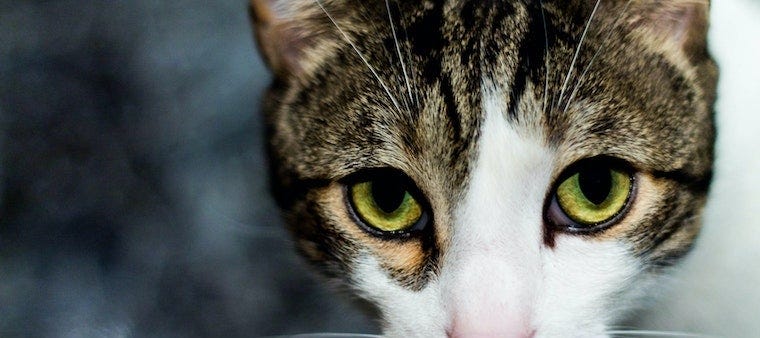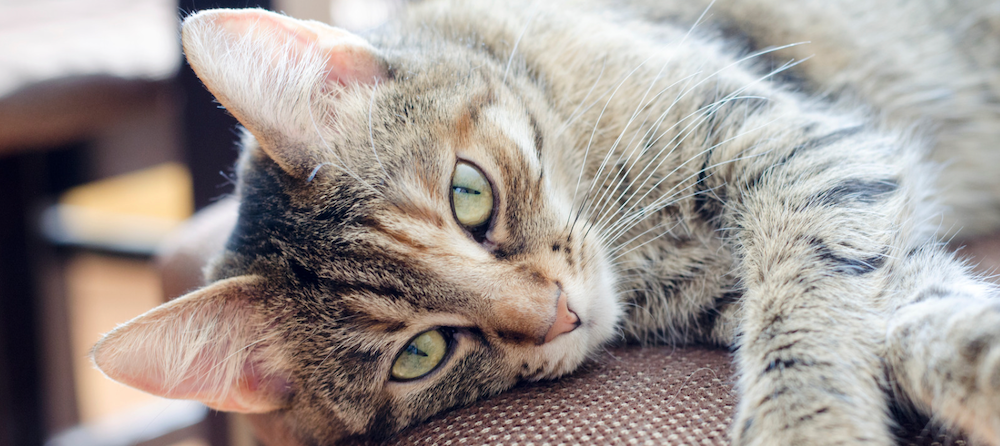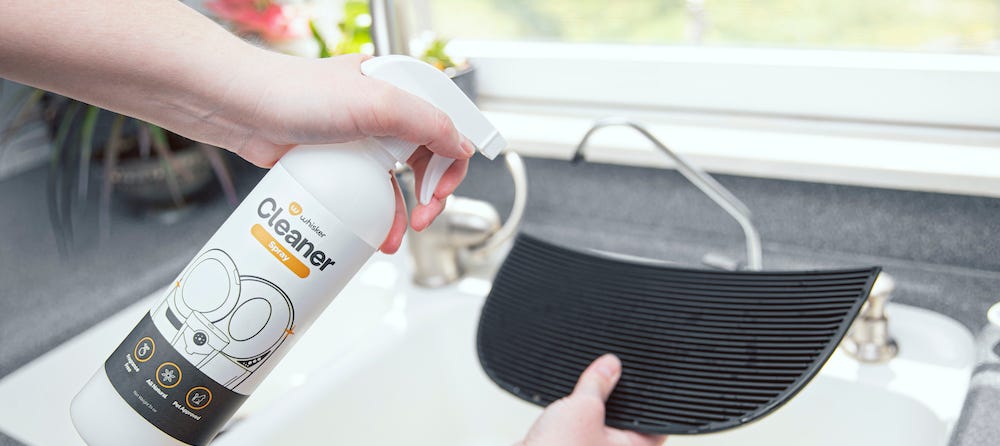As a veterinarian and cat lover, my favorite part of cats are their eyes: Our feline creatures have the most beautiful, expressive eyes. From their “window to the soul,” you can tell when your cat is content versus when your cat is giving you the stink eye. Like humans, cats can develop eye problems, however. So, if you ever wondered if your cat can get cataracts, if glaucoma occurs in cats, and what some of the most common cat eye problems are, read on!
Anatomy of the eye
First, let’s start with the anatomy of the eye. The anatomy of the eye is very similar between dogs, cats, and humans—they all have similar structures like the cornea, pupil, iris, lens, retina/tapetum lucidum, and the optic nerve. All of these parts of the eye are housed in the “globe” of the eye (the entire “eyeball”). Dogs and cats also have a third eyelid in the inside corner of their eye which helps protect their eye from trauma, injury, or even dryness. The entire globe is surrounded by a thin sheet of whitish/pink-tinged tissue called the conjunctiva, which is under the eyelids. Each of these delicate parts of the eye play an important role including:
- Cornea: the clear “windshield” of the eye, which protects the eyeball
- Pupil: the vertical slit-like to round part of the center of the eye that lets light into the back of the eye
- Iris: the pigmented (e.g., green, blue, brown, copper, etc.) circular membrane that surrounds the pupil and also responds to light
- Lens: the invisible “contact lens-like” structure that helps the eye focus
- Retina/tapetum lucidum: the thin membrane that lines the inside part of the eyeball that sends the visual information to the brain; this is what often results in “red eye” in photos taken with a flash. The rods and cones of the eye live in this area, and in the cat, contribute to such astute night vision
- Optic nerve: the large nerve that connects from the retina to the brain
- Sclera: the “white” of the eye typically hidden by the eyelids
What are the signs of common cat eye problems?
Clinical signs of ocular disease in your cat will vary, depending on where anatomically the eye problem may be. General signs of eye problems in cats include:
- Excessive tearing (called epiphora)
- Squinting
- Redness to the eye
- Discharge from the eye (e.g., green, yellow, cloudy)
- Discoloration or cloudiness of the surface of the eye
- Third eyelid elevation
- Swelling or prominent “pink” conjunctival tissue
- Keeping the eyes closed
- Uneven or inappropriately dilated pupil(s)
- Black spots on the eye
- Haziness or lack of “sharpness” to the iris
- Abnormal appearance to the eye
- Eye pain or discomfort
- Sneezing or drooling (from a secondary URI)
- Pawing at the eye
- Discoloration of the sclera (e.g., like bruising or bleeding or even a yellow appearance from liver disease)
- Lumps or masses or asymmetry of the eyelids
- Sensitivity to light
- Sunken eye
- Bulging or protruding of the eye (called exophthalmos)
- Vision loss/blindness
As you can see, that’s a pretty long list of signs that your cat has an eye problem! If you notice any of these signs, get to a veterinarian immediately!
What tests does my veterinarian need to do to diagnose an eye problem in my cat?
Once you get to your veterinarian, they’ll need to get a thorough history, do a thorough physical examination, and do specific ocular tests. Specific questions your veterinarian may ask you include:
- Does your cat go outdoors?
- Is your cat vaccinated for feline leukemia (FeLV)?
- Does your cat fight with other animals?
- Is your cat drinking or urinating excessively?
- Have you introduced any new cats to your household?
- Is there any history of feline infectious peritonitis (FIP) or medical problems in your cat’s parents or siblings?
As for ocular tests, these will include a Schirmer tear test (STT) to test the tear function of your cat’s eye, a fluorescein stain to see if your cat has scratches or ulcers on the eye, corneal cytology to look at the cells on your cat’s cornea, and sometimes even an intraocular pressure to test for glaucoma.
Depending on what your cat is diagnosed with, it may even require more extensive testing to rule out a systemic (e.g., whole body) infection. These include blood tests to see if your cat has underlying infections (like FeLV or FIP) or viral infections. Additional blood work to check your cat’s general health (like a complete blood count and chemistry panel) should also be done to rule out kidney disease, hyperthyroidism, liver problems, an infection, and more. A urine test may need to be done to rule out diabetes mellitus, and a blood pressure should be done to rule out hypertension.
What is the treatment for common cat eye problems?
Depending on what the underlying cause is, treatment will vary from topical ophthalmic antibiotics, oral and topical antiviral medications, pain medications, atropine to dilate the pupils, a funnel hat to prevent further injury, steroid drops, or even different types of surgery. We’ll talk more about specific treatment next month with each eye problem.
Common eye problems in cats
There are several common cat eye problems or cat eye diseases. Some may be minor and result in irritation, while others can result in potential blindness or vision loss—even with treatment. While some of these diseases are less common than others, I listed them in alphabetical order below in this 2-part blog. We’ll discuss what these problems are, what signs they show, and how to treat them in Part 2, so make sure to check that out for the remaining eye problems in cats!
- Cataracts
- Conjunctivitis
- Corneal disease
- Eyelid abnormalities (e.g., entropion, eyelid mass)
- Glaucoma
- Globe abnormalities
- Iris abnormalities (e.g., melanosis, melanoma)
- Keratoconjunctivitis
- Retinal damage (e.g., retinal detachment)
- Uveitis
Prognosis
The prognosis for cat eye problems is excellent to poor, depending on what the diagnosis is and what the response to treatment is. Next month, I’ll go into more details on each specific disease and what you need to know!
Preventing common cat eye problems
Believe it or not, there are some things you can do to prevent eye problems in cats!
First, make sure to routinely check your cat’s eyes. If you notice any discoloration, masses, cloudiness, redness, swelling, excessive tearing or discharge, signs of itchiness, or rubbing of the face, get to a veterinarian immediately!
Second, by simply keeping your cat indoors, you can avoid some of these common cat eye problems (from infectious causes to traumatic causes or even irritant causes!).
Third, if you bring a new cat into the household, please make sure to quarantine that cat for at least 1-2 weeks. This will ensure that a URI isn’t transmitted to the original house cats. If you are introducing cats to each other, do so slowly and make sure to trim all nails before any cats connect.
Lastly, routine veterinary visits are a must, especially as your cat ages. Certain diseases like chronic kidney disease, diabetes mellitus, and hyperthyroidism can also result in systemic changes to the body and secondary eye problems.
When in doubt, if there’s a problem, we want to diagnose the problem sooner—that way we can fix it and treat it without any long-term secondary effects. The sooner you recognize an abnormality in your cat’s eye, the sooner the disease can be treated and the better the outcome and likelihood of retaining vision.
Cover photo by Anton Petrov on Unsplash









